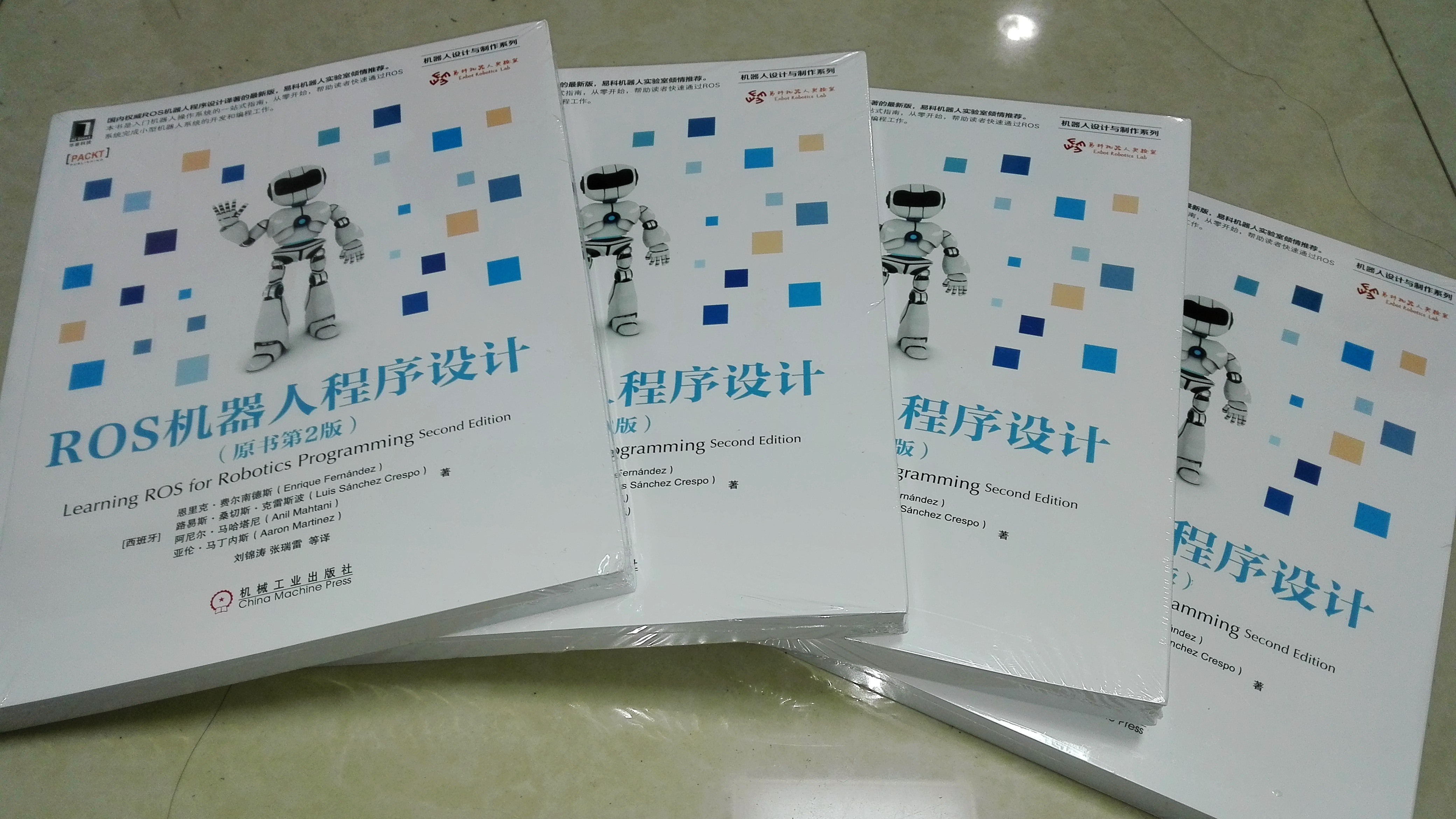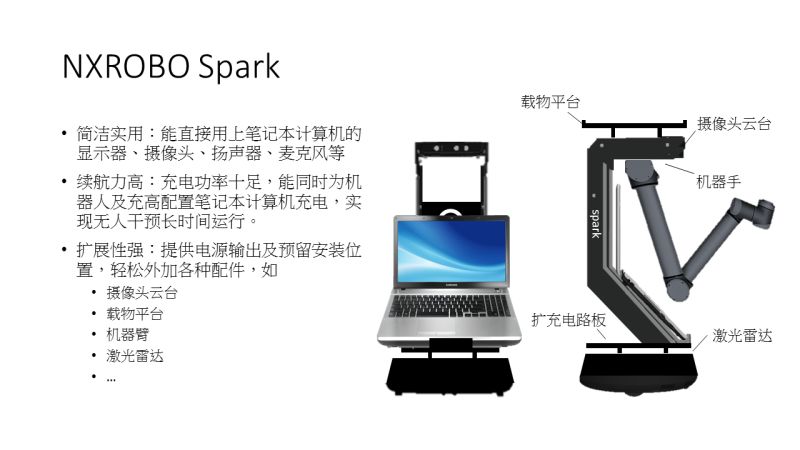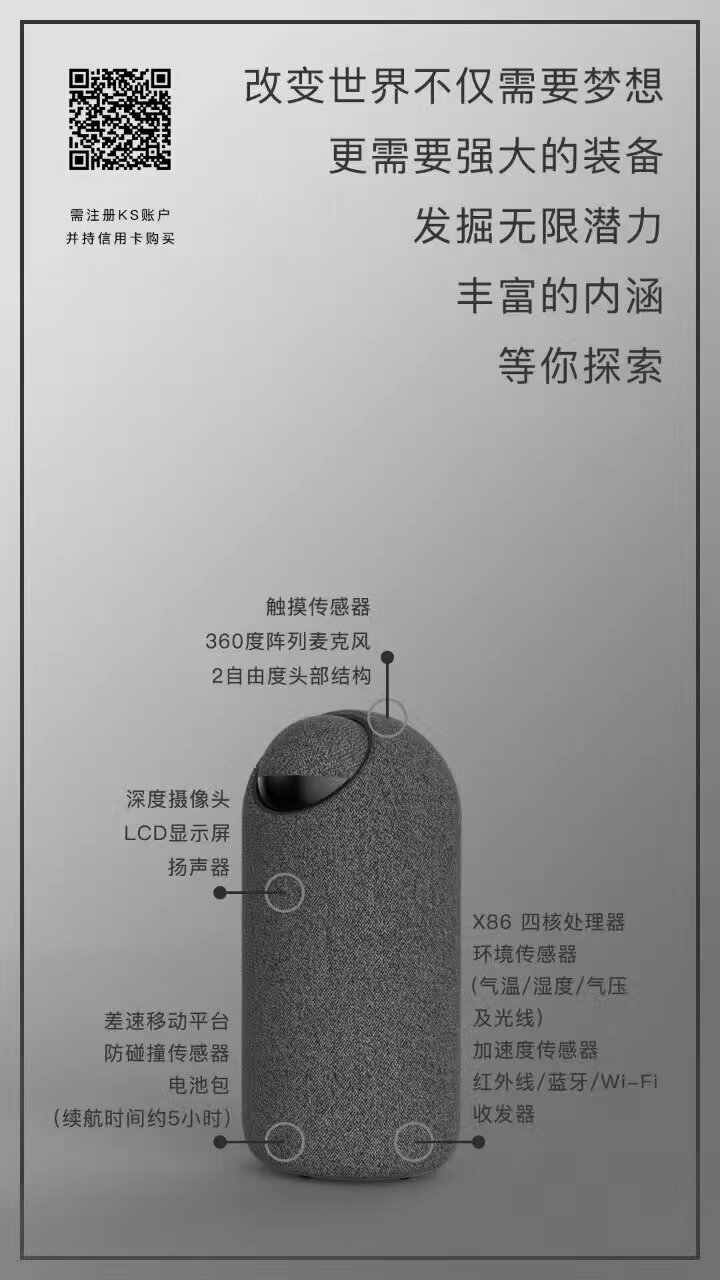ROS机器人程序设计(原书第2版)补充资料 (零) 源代码等
- ROS官网
- |易科
- |虞坤林
- |古月居
- |ROSClub
- |创客智造
-
ROS机器人操作系统在线练习课程正在逐步完善中,目前以ROS官网中文资料制作,
可参考:https://www.shiyanlou.com/courses/854 邀请码 U23ERF8H
书中,大部分出现hydro的地方,直接替换为indigo或jade或kinetic,即可在对应版本中使用。
kinetic:https://github.com/rosbook/effective_robotics_programming_with_ros
kinetic版本章节顺序有所调整。
在文末更新kinetic版本说明。补充说明以indigo为主,但教案幻灯片等以kinetic制作,
Ubuntu 14.04 + ROS indigo镜像已经发布,Ubuntu 16.04 + ROS kinetic纯净版镜像,如下:
http://blog.csdn.net/zhangrelay/article/details/54632130
稍后会补充,各章节针对indigo版本和kinetic版本的修正说明,方便读者阅读。
完整系统的学习ROS请不要忽略官网或书中的一些细节,非常重要。
如果长期使用Ubuntu和ROS,推荐LTS版本。
如果之前没有接触过Linux,推荐鸟哥的Linux私房菜,下面给出繁体中文和简体中文网址:
繁体:http://linux.vbird.org/ 简体:http://cn.linux.vbird.org/
新版学习配套镜像已经发布,详情请参考,U盘启动Live CD无需安装即可体验Ubuntu+ROS:
http://blog.csdn.net/zhangrelay/article/details/53324759
可以选用的完整镜像参考:http://blog.csdn.net/zhangrelay/article/details/50176685
用户名:relaybot;密码:cslg。
已经预装ROS indigo,U盘体验ROS或安装完使用,书中全部案例。如果需要了解ROS的实时性,请点击下载。
hydro indigo jade kinetic
书中部分已经发现的印刷错误修订:
ROS机器人程序设计(原书第2版)部分内容修订
35页:最下面命令改为:rostopic pub /turtle1/cmd_vel geometry_msgs/Twist -r 1 – ‘[1.0, 0.0, 0.0]’ ‘[0.0, 0.0, 1.0]’
删去
float32 angular41页:最后可以使用–pkg参数
47页:example1_a.cpp改为example3_a.cpp和example1_b.cpp改为example3_b.cpp
50页:加入cd cfg
51页:添加参数那只有4个,少了个 gen.add(“size”, int_t, 0, “Select from the list”, 1, 0, 3, edit_method=size_enum)
60页:第1行,删去</span></span></strong></span></p><p><span style="font-size:12px;"><strong><span style="color:#ff0000;"><span style="font-family:Calibri;">93</span>页:第<span style="font-family:Calibri;">6</span>行,<span style="font-family:Calibri;">float64 y </span>前面加一个空格</span></strong></span></p><p><span style="font-size:12px;"><strong><span style="color:#ff0000;"><span style="font-family:Calibri;">223</span>页:中间创建主题:下面程序不用换行,(<span style="font-family:Calibri;">”scan”, 50</span>)</span></strong></span></p><p><span style="font-size:12px;"><strong><span style="color:#ff0000;"><span style="font-family:Calibri;">261</span>页:最后<span style="font-family:Calibri;">10</span>行,顺序错乱:</span></strong></span></p><p><span style="font-size:12px;color:#ff0000;"><strong> 在你的<span style="font-family:Calibri;">CMakeList.txt</span>添加<span style="font-family:Calibri;">***</span>:</strong></span></p><p><span style="font-family:Calibri;font-size:12px;color:#ff0000;"><strong> add_executable(**)</strong></span></p><p><span style="font-family:Calibri;font-size:12px;color:#ff0000;"><strong> target_link_libraries(**)</strong></span></p><p><span style="font-size:12px;color:#ff0000;"><strong> 现在,使用下面命令编译功能包:</strong></span></p><p><span style="font-family:Calibri;font-size:12px;color:#ff0000;"><strong> <script type="math/tex" id="MathJax-Element-1">
93页:第6行,float64 y 前面加一个空格
223页:中间创建主题:下面程序不用换行,(”scan”, 50)
261页:最后10行,顺序错乱:
在你的CMakeList.txt添加***:
add_executable(**)
target_link_libraries(**)
现在,使用下面命令编译功能包:
</script> catkin_make
下一步就是使用启动文件**:
roslaunch chapter9 ***</strong></span></p><p><span style="font-family:Calibri;font-size:12px;color:#ff0000;"><strong> roslaunch ***
$ rosrun ***
196页:参考留言,书本是按原文原版翻译的。
非常感谢陈鹏飞等对书中错误的告知。
前言部分内容补充:
第X页:
源码下载:
本书源码:https://github.com/AaronMR/Learning_ROS_for_Robotics_Programming_2nd_edition
目前,支持ROS hydro,indigo,jade三个版本。
Learning ROS for Robotics Programming Book repository - 2nd, 3rd edition - ROS hydro, indigo, jade, kinetic
推荐机器人官方turtlebot1、2、3,SparkX等。
已开设专栏介绍(持续更新):
ROS Indigo:http://blog.csdn.net/column/details/13335.html
ROS Kinetic:http://blog.csdn.net/column/details/13113.html
原版使用说明:
ROS机器人程序设计(原书第2版)
Learning ROS for Robotics Programming - Second Edition book tutorials source code.
Authors 作者
Installation 安装:请依据ROS版本进行选择
Install ROS Indigo on a compatible Ubuntu distro following the official instructions provided here.
For ROS Hydro use the hydro-devel branch.
For ROS Jade use the jade-devel branch.
安装OpenCV的非自由库:
sudo add-apt-repository --yes ppa:xqms/opencv-nonfree sudo apt-get install libopencv-nonfree-dev libopencv-nonfree2.4
创建工作区:
mkdir -p ~/dev/catkin_ws/src cd ~/dev/catkin_ws/src wstool init
下载此资料库:
wstool set ros_book --git git@github.com:AaronMR/Learning_ROS_for_Robotics_Programming_2nd_edition.git wstool up -j8安装依存关系:
cd .. rosdep install --from-paths src -iy编译源代码(或者,您可以使用catkin build替代catkin_make):
source /opt/ros/$(rosversion -d)/setup.bash catkin_make -j4 source devel/setup.bash
Tutorials 教程
- Chapter 1: Getting started with ROS (no source code as it covers the installation)
- 第一章 ROS系统入门
- Chapter 2: ROS Architecture and Concepts
- 第二章 ROS系统架构及概念
- Chapter 3: Visualization and Debug Tools
- 第三章 可视化和调试工具
- Chapter 4: Using Sensors and Actuators with ROS
- 第四章 在ROS中使用传感器和执行器
- Chapter 5: Computer Vision
- 第五章 计算机视觉
- Chapter 6: Point Clouds
- 第六章 点云
- Chapter 7: 3D Modeling and Simulation
- 第七章 三维建模与仿真
- Chapter 8: The Navigation Stack - Robot Setup
- 第八章 导航综合功能包入门
- Chapter 9: The Navigation Stack - Beyond the Setup
- 第九章 导航综合功能包进阶
- Chapter 10: Manipulation with MoveIt!
- 第十章 使用MoveIt!
- Kinetic -
Installation
Install ROS Kinetic on a compatible Ubuntu distro following the official instructions provided here.
Install the OpenCV non-free repository:
sudo apt-get install software-properties-common python-software-properties sudo add-apt-repository --yes ppa:xqms/opencv-nonfree sudo apt-get install libopencv-nonfree-dev libopencv-nonfree2.4v5
Create a workspace:
mkdir -p ~/dev/catkin_ws/src cd ~/dev/catkin_ws/src wstool init
Download this repository:
wstool set ros_book --git git@github.com:rosbook/effective_robotics_programming_with_ros.git wstool up -j8Install the dependencies:
cd .. rosdep install --from-paths src -iyBuild the source code (alternatively, you can use
catkin buildinstead ofcatkin_make):source /opt/ros/$(rosversion -d)/setup.bash catkin_make -j4 source devel/setup.bash
Tutorials
- Chapter 1: Getting started with ROS (no source code as it covers the installation)
- Chapter 2: ROS Architecture and Concepts
- Chapter 3: Visualization and Debugging Tools
- Chapter 4: 3D Modeling and Simulation
- Chapter 5: The Navigation Stack - Robot Setups
- Chapter 6: The Navigation Stack - Beyond Setups
- Chapter 7: Manipulation with MoveIt!
- Chapter 8: Using Sensors and Actuators with ROS
- Chapter 9: Computer Vision
- Chapter 10: Point Clouds

























 1万+
1万+

 被折叠的 条评论
为什么被折叠?
被折叠的 条评论
为什么被折叠?








